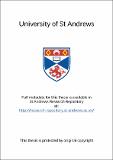Files in this item
Sir David Wilkie : his creative processes, with special reference to 'Blind man's buff' and 'Sir David Baird discovering the body of Tippoo Sahib'
Item metadata
| dc.contributor.advisor | Miles, Hamish | en |
| dc.contributor.advisor | Campbell, Patsy | en |
| dc.contributor.author | Johnston, Charlotte | en |
| dc.coverage.spatial | 113p, 66p of plates. | en |
| dc.date.accessioned | 2021-04-08T08:59:42Z | |
| dc.date.available | 2021-04-08T08:59:42Z | |
| dc.date.issued | 1987 | |
| dc.identifier.uri | https://hdl.handle.net/10023/21971 | |
| dc.description.abstract | For most of his paintings, Wilkie made a substantial body of preparatory work, and it is chiefly through the examination of such studies that we are able to trace his creative processes. Such an exercise reveals the changes which took place in his methods of composition, the way in which he responded to the different demands of the subjects with which he dealt, as his career progressed. The thesis looks specifically at the drawings relating to two of his paintings, one, a typical genre scene of 1813, Blind Man's Buff (Royal Collection, Buckingham Palace), and one a history piece and portrait of 1839, Sir David Baird discovering the body of Tippoo Sahib (National Gallery of Scotland). The studies and sketches are analysed in detail, in order to attempt to uncover the pattern of the development of Wilkie's ideas, in each case. The overall picture which emerges from this is of two quite distinct ways of working. The catalogues given at the end of the thesis list all the known extant studies and sketches for the paintings in question. | en |
| dc.language.iso | en | en |
| dc.publisher | University of St Andrews | en |
| dc.subject.lcc | ND478.W5J7 | |
| dc.subject.lcsh | Wilkie, David, Sir, 1785-1841 | en |
| dc.title | Sir David Wilkie : his creative processes, with special reference to 'Blind man's buff' and 'Sir David Baird discovering the body of Tippoo Sahib' | en |
| dc.type | Thesis | en |
| dc.type.qualificationlevel | Doctoral | en |
| dc.type.qualificationname | MLitt Master of Letters | en |
| dc.publisher.institution | The University of St Andrews | en |
This item appears in the following Collection(s)
Items in the St Andrews Research Repository are protected by copyright, with all rights reserved, unless otherwise indicated.

